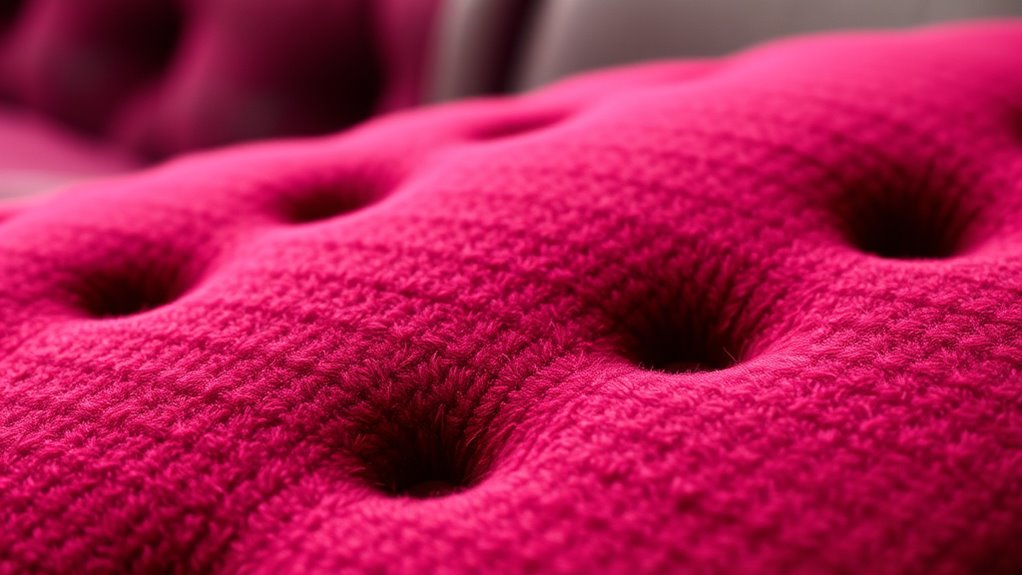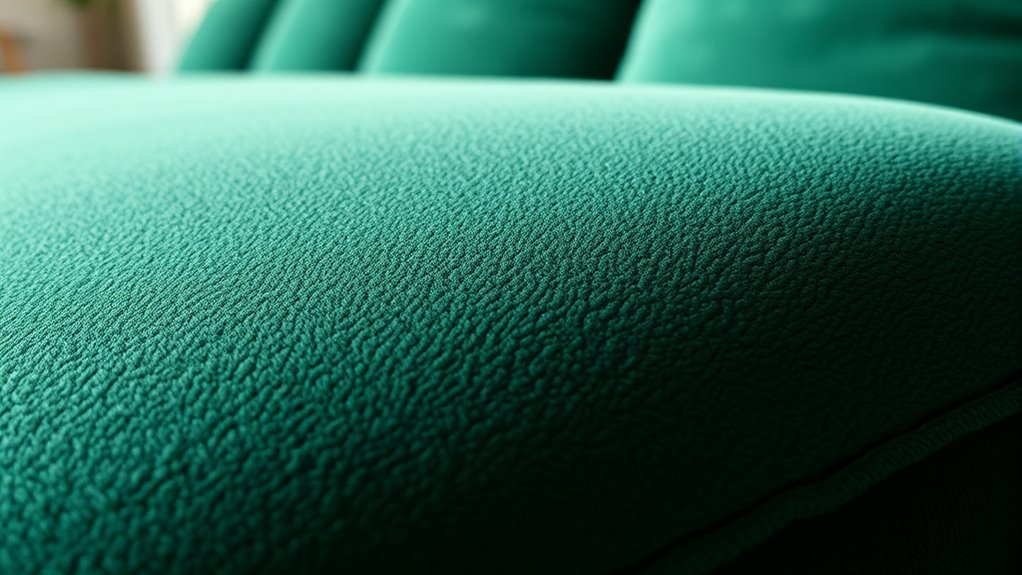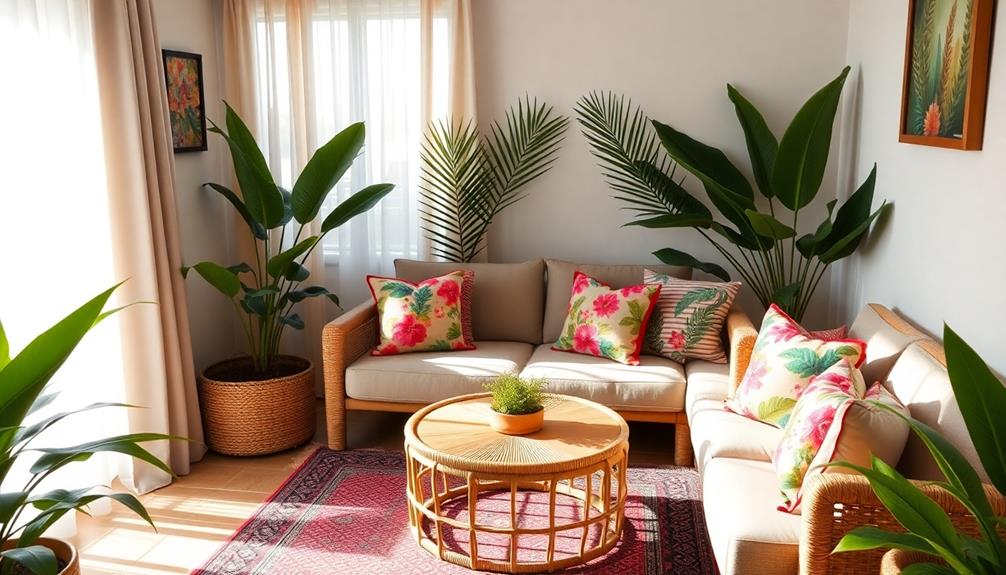Your sofa fabric impacts your emotional comfort and subconscious reactions every day. Soft, plush textiles can promote relaxation and a sense of security, while rough or coarse textures might cause discomfort or agitation without you realizing it. The right fabric aligns with your preferences and influences how grounded and at ease you feel in your space. Curious about how choosing the perfect texture can transform your mood? Keep exploring to discover more about the power of tactile choices.
Key Takeaways
- Sofa fabric texture influences emotional comfort and mood through tactile perceptions, affecting relaxation and overall well-being.
- Soft, plush materials evoke feelings of luxury and calm, promoting a sense of safety and stress relief.
- Coarse or rough textures may cause discomfort or agitation, impacting subconscious responses and emotional state.
- Selecting fabrics aligned with personal preferences enhances sensory harmony and creates inviting, soothing spaces.
- Tactile qualities of sofa fabrics shape the emotional atmosphere of a room, influencing feelings of security and relaxation.

Texture plays a surprisingly powerful role in how we perceive and respond to the world around us. When you touch a surface, your sensory perception kicks in, sending signals to your brain that influence your mood and feelings. This is especially true for the fabrics and textures in your environment, like your sofa. The way it feels under your fingertips can profoundly impact your emotional comfort, making you feel relaxed, energized, or even anxious. The tactile qualities of your sofa aren’t just about aesthetics—they directly shape your daily experience and emotional well-being. When you settle onto a plush, soft fabric, your nervous system registers that gentle touch as soothing, helping you unwind after a long day. Conversely, rough or coarse textures might create a sense of discomfort or agitation, even if you’re not consciously aware of it.
You might not realize it, but the textures you choose for your space influence your subconscious responses. Smooth, velvety materials tend to evoke feelings of luxury and calm, triggering a sense of emotional safety. These fabrics often appeal because they mimic the softness we associate with comfort and care. On the other hand, textured fabrics with nubby or coarse surfaces can evoke different reactions—they might feel more stimulating or even overwhelming, depending on your personal preferences and sensitivities. This is why understanding your sensory perception is vital when selecting textures; what feels cozy and inviting to one person might feel abrasive or unsettling to another.
Your emotional comfort isn’t just a matter of aesthetics but also of sensory harmony. When a sofa’s texture aligns with your personal preferences, it creates an environment where you naturally feel more at ease. This is especially important in spaces meant for relaxation, like living rooms or bedrooms. An inviting fabric can encourage you to linger longer, to feel more grounded and secure in your surroundings. It’s not merely about appearance but about how the touch interacts with your nervous system, shaping your overall mood. If you’re sensitive to certain textures, choosing the right fabric can minimize stress and enhance your sense of calm.
In the end, the texture of your sofa isn’t just a design choice—it’s a fundamental component of your emotional landscape. Paying attention to how different fabrics feel under your fingertips helps you craft a space that nurtures your well-being. By understanding the link between sensory perception and emotional comfort, you can select textures that support relaxation, reduce stress, and make your living space genuinely feel like home.
Frequently Asked Questions
How Does Sofa Fabric Influence Mood and Emotional Well-Being?
Your sofa fabric influences your mood and emotional well-being through sensory perception and emotional resonance. Soft, cozy textures can make you feel relaxed and secure, while rough or stiff fabrics might cause discomfort or stress. By choosing fabrics that appeal to your senses, you create a space that promotes positive feelings and emotional comfort, ultimately affecting how you experience your environment and interact within it.
Can Texture Choices Affect Social Interactions in a Living Space?
Imagine your living space transforming into a social magnet—your fabric sensory choices do exactly that. When you pick textured fabrics, you invite tactile engagement, making conversations flow smoother, and connections deepen. Coarse or smooth, your sofa’s fabric influences comfort levels and openness, turning ordinary gatherings into extraordinary moments. Your choice of tactile engagement can subtly but powerfully shape how people interact, making your space the ultimate hub of warmth and connection.
Do Different Textures Have Cultural or Historical Significance?
You might notice that different textures hold cultural symbolism or trace back to historical origins. For example, intricate textiles like Persian rugs or Japanese silk carry deep cultural meanings, reflecting traditions and values. These textures often symbolize status, identity, or craftsmanship. By choosing specific fabrics, you connect with a rich history and cultural significance, adding depth to your living space and enriching your understanding of diverse cultural expressions through texture.
How Does Fabric Durability Impact Psychological Comfort Over Time?
Did you know that 70% of people say their sofa’s comfort affects their mood? Fabric durability influences your psychological comfort by making maintenance easier and preserving color psychology over time. When your fabric withstands daily wear, you feel more relaxed and confident in your space. Durable fabrics reduce stress, as you don’t worry about stains or fading, ensuring your environment remains inviting and emotionally soothing.
Are There Specific Textures Recommended for Reducing Stress?
If you’re looking to reduce stress, opt for sofa fabrics that offer gentle tactile comfort and calming textures. Soft, smooth materials like velvet or linen provide sensory stimulation that promotes relaxation, while textured fabrics like boucle or chenille can add cozy tactile comfort. Choosing fabrics with soothing qualities helps create a tranquil environment, allowing you to unwind more easily and enjoy a sense of calm in your space.
Conclusion
Choosing the right sofa fabric isn’t just about style—it’s about how it makes you feel. Maybe you think texture isn’t that important, but imagine sinking into a plush, soft fabric that instantly relaxes you after a long day. Don’t overlook the power of texture; it can transform your space into a comforting retreat. After all, your sofa isn’t just furniture—it’s where your mind finds calm.









